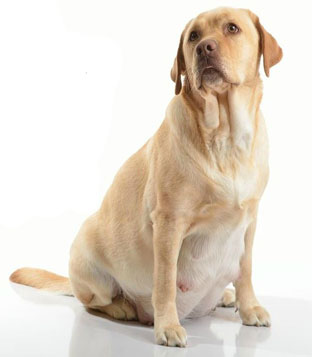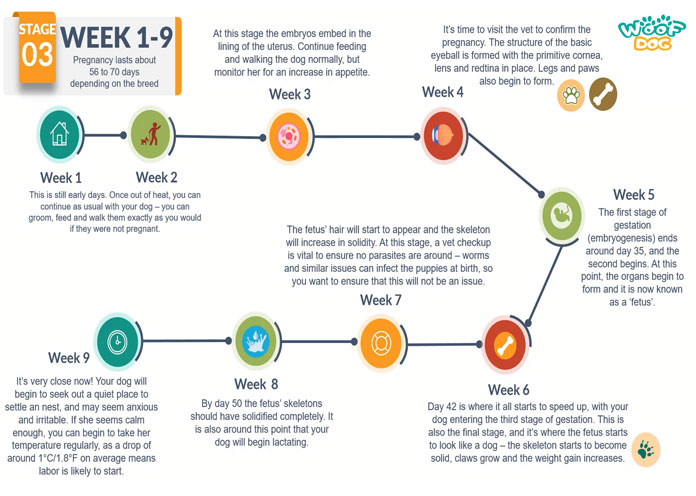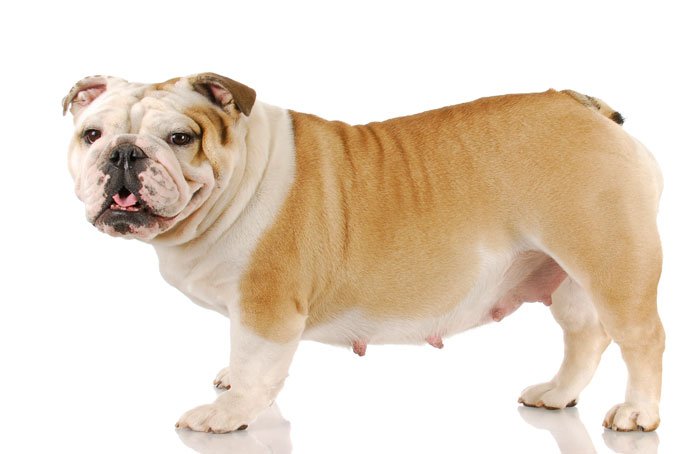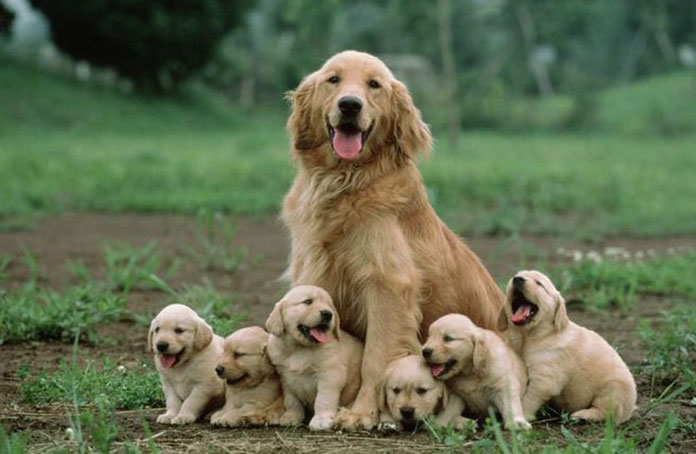Stages of Dog Pregnancy – Weekly Calendar with Photos
There’s a whole host of reasons you might have a pregnant dog – whether deliberate breeding, accidental conception or fostering/adopting a dog who is already pregnant. In all of these cases, it’s important to be informed and up to date on what is happening and what to expect, just as you would with any other health condition.
We’ll start with the assumption that you’re planning to breed your dog, but if that’s not the case and they’re already pregnant, then please do skip ahead!
Before The Pregnancy
If you planned the pregnancy, there’s a bunch of things you should check in advance – just like with people! Firstly, and most importantly, make sure your dog is the right age. You want to ensure they’re older than 2 – ideally, 3! – to make sure they’re fully mature, as well as considering the upper limit.
The average is 5, but this may vary depending on breed, so do speak to your vet about it. You also need to make sure that they’re fully up to date on their vaccinations.

Different breeds have various issues, and it’s worth making sure you know about what these are. Indeed, there are some breeds that it is very inadvisable to try for litters with. Other small dogs tend to have complicated pregnancies, so corgis and similar breeds are trickier than others, like medium size mongrels.
If a dog is a brachycephalic breed, then they will likely need a cesarean. Though, there will be certain screening procedures available – some of which are optional, some of which are vital. As an example, let’s look at what needs to be done to breed an Old English Sheepdog as an example.
- Ensure the dog is mature and with a stable temperament.
- Take advantage of genetic testing where possible, with a particular focus on common breed issues including primary ciliary dyskinesia, multi drug resistance, exercise induced collapse and degenerative myelopathy.
- Consider optional testing for aesthetics, such as testing for the bobtail gene and coat color to match to an ideal mate.
- Find an ideal mate, and ensure they have also had genetic testing done.
- Have copies of all relevant medical information from both parties in advance.
- Have your dog assessed by a vet to ensure they are physically ready for pregnancy, and make sure you’re happy with the vet as a point of contact.
- Make sure you know where you plan to have them give birth and stay afterward.
- Be prepared for the first mate/mating not to be a success!

Mating
There’s no guarantee that any two dogs will get on well enough to mate, but you can increase the chances in a few ways. Firstly, ensure they meet for the first time on the neutral ground to reduce territorial aggression.
It can also be worth having them meet a couple of occasions out of heat to ensure there is no aggression, and to confirm you are happy with the temperament of the father.
Once she is in heat, you will find their encounter can be quite quick! There will often be a brief courting phase, but this can sometimes be over in less than a minute, depending on experience. It is important to be aware of the physiological response that will occur here – the female will ‘lock’ the male into her until completion, and this can last for anything from 15 to 30 minutes.
The male may even turn around during this. It is vital that you do not interrupt this as it could cause damage to either party.
As with all species, a successful mating does not guarantee successful or instant fertilization. The sperm can survive for nearly a week so that it may take a while!
Many breeders will leave two days after the first mating, before seeing if another will occur to increase chances.
It is possible to have blood tests done to work out the optimum fertile window, but this is not a requirement.

Once you have left enough time, you can also check your dog using a store bought kit to see if it was successful. Do not use flea treatments or wormers during this time, unless advised by a vet.
Stages of Canine Pregnancy Week By Week
Weeks One and Two
An average pregnancy lasts for anything from 56 to 70 days depending on the breed, so this is still early days. Once out of heat, you can continue as usual with your dog – you can groom, feed and walk them exactly as you would if they were not pregnant.
It is not advertised to increase feed yet, as their weight should remain relatively stable, increasing by no more than 10%. This advice should be followed up until around day 42, though if you notice any severe differences (especially weight loss), you should get in touch with your vet.
No supplements are needed at this stage unless prescribed by your vet.
Week Three
At this stage, the embryos embed in the lining of the uterus, which is where they will develop. Continue feeding and walking the dog normally, but monitor her for an increase in appetite. However, do not change her diet at this point.
Week Four
Around day 25 (from after mating), it’s time to visit the vet for a more formal check. They will be able to perform an ultrasound which will be able to confirm the pregnancy. It will also give you a vague idea of litter size, though this should be treated as an estimate, not a guarantee. It’s also the first opportunity to catch any problems.
There is an alternative method of confirming pregnancy, which involves a blood test to discover the level of relaxin (a hormone that is only created by the placenta). If you want more information, you should ask for an ultrasound instead.
This is a delicate time, so while you should not cease exercising the dog, you should become more careful – limit rough play and make sure they don’t strain themselves!

Week Five
The first stage of gestation (embryogenesis) ends around day 35, and the second begins. At this point, the organs start to form, and it is now known as a ‘fetus.’ During this phase, the weight of the fetus increases dramatically – around 75%!
The initial delicate stage will be over, and while you need to remain cautious with rough play and strenuous exercise, there is less risk of developmental issues. You may notice your dog’s weight increase and her appetite increase as well, but don’t worry if this doesn’t happen quite yet. Start to adjust her diet accordingly (though again, avoid dramatic changes).

Week Six
Day 42 is where it all starts to speed up, with your dog entering the third stage of gestation. This is also the final stage, and it’s where the fetus starts to look like a dog – the skeleton starts to become solid, claws grow and the weight gain increases.
This is the point at which you will need to adjust your dog’s diet if you haven’t already. She will need more protein and a higher energy content, despite the decreased appetite she may seem to gain. This is simply a matter of discomfort, and changing the meal schedule to smaller meals throughout the day rather than two or three main ones is recommended if this is the case. Following your vet’s advice, you may wish to add in a multivitamin to her diet.
Week Seven
The fetus’ hair will start to appear, and the skeleton will increase in solidity. At this stage, a vet checkup is vital to ensure no parasites are around – worms and similar issues can infect the puppies at birth, so you want to make sure that this will not be a problem. If the dog has started to shed from her belly, this is fine – it’s just preparation for the birth.
You also want to prepare for the mother to give birth – to whelp, as it is known – just in case! Choose a place that is quiet and rarely disturbed. It is important that it is easy to clean, keep warm, and that it is safe and secure.
This place will be used for the first few weeks after whelping as well as during, so make sure you won’t need it anytime soon. Some people suggest setting up a ‘whelping box’ within the room itself, and this can be a good idea though be aware that it doesn’t guarantee your dog will use it.
A simple cardboard box with a heat pad and blankets works just fine. If you plan on breeding more often, you could invest in a more expensive reusable one, but this is in no way required!
Week Eight
By day 50 the fetus’ skeletons should have solidified completely. You can request an x-ray at this point, but the vet may decide it is not necessary and is, in fact, two invasive. It can be a useful chance to confirm litter size, however.
Now is the chance to make last minute adjustments to the whelping area – make sure you have enough bedding, a safe heater (and possibly humidifier) and that the room is fully prepared.
It is also at this point that your dog will begin lactating – a good estimate of when she’s likely to give birth, as it’s usually a week in advance. If this doesn’t happen when expected, consult a vet and ensure you have a substitute available. It’s wise to have an alternative available even if she does lactate, to accommodate other potential issues.
While some will advise that you groom them (gently) in week nine, we suggest considering it now before your dog is too on edge. She doesn’t need a proper groom, but trimming the hair around the vulva and teats can make things easier on both her and you.
Week Nine
It’s very close now! Your dog will begin to seek out a quiet place to settle an nest and may seem anxious and irritable. Encourage her towards the room you’ve chosen and the box if you have one.
Line the floor with layers of newspaper to ensure sufficient insulation (and absorption), and then cover this with clean towels, sheets or blankets – anything comfortable that you are happy to wash as you’ll have to change this frequently!
If she seems calm enough, you can begin to take her temperature regularly, as a drop of around 1°C/1.8°F on average means labor is likely to start. However, this should only be done if it won’t stress the mother out.
For the first 24 hours, the room should be kept at around 30°C/86°F. After this you’ll want it to maintain a temperature of around 25°C/77°F as young puppies cannot maintain their temperature.
Giving Birth (Whelping)
Most dogs manage this part just fine by themselves, but that doesn’t mean you can just leave them to it. If nothing else, you will be acting as a comfort to them and ensuring their needs are met. Make sure you don’t show signs of stress if possible, as this will only stress out the dog.
You also need to keep an eye on how things are going, so that you can intervene if necessary. If you’re not sure what to look for, talk to a vet in advance as they will give you an idea of what to expect, what to watch out for, and when to call them if needed.
For some dogs, labor can be over in a few minutes – for some. It can be a matter of hours. If it seems to be going on for a while, you can check on them every quarter of an hour or so.
Things to watch out for that suggest there may be issues include the labor starting too early (before day 57) or too late (after day 68), more than three hours between puppies and the initial stage of labor lasting for more than 4 hours.
Other signs include contractions reducing or ceasing part way through birthing, puppies getting stuck in the birth canal, many puppies coming out at the same time, a fetal sack that contains no animals coming, signs of distress from the mother or an apparent birth defect in one of the birthed puppies.
All of these require veterinary attention. Stillborn puppies can happen, and there is often little that could have been done to prevent this stages of.
Once they have delivered the first puppy, they should tear open the fetal sack. If they don’t, you can do this yourself while wearing disposable gloves. Make sure you wash your hands properly before and after!
It can take anything from minutes to hours for the rest of the puppies to follow, but it’s usually within 1 or 2 hours. Not all puppies will be born head first – you’ll often see the back feet first – and that’s fine.
You may see the mother eat the placenta – once again, this is normal but not required. If you do not see the placenta pass, talk to a vet as this could become an issue in the future.
Whatever you do, do not pull the puppies free, as this could cause severe damage to the mother and the puppy. If you are concerned, seek advice from a vet.
If a puppy appears still, rub it gently with a clean towel to stimulate it – avoid using cold water or a hair dryer as there is again, severe risk. Once again, if there is anything you’re not certain about, get in touch with your vet – better safe than sorry!

Recovery
As soon as you are sure she is finished, you should remove all the soiled material and replace it with clean bedding (as long as this can be done with a minimum of distress). You will need to repeat this process frequently.
If necessary, clean the mother with a warm, damp cloth, but avoid doing the same to the puppies. Ensuring she is free from blood, fluid or tissues will help reduce the chance of infection. She is likely to leak for a few weeks after giving birth, and this is fine unless it becomes gray or smells, in which case she may have an infection.
Some dogs become very picky after giving birth so make sure that you give them more tasty food with a good amount of protein since pups will draw everything with milk. You can feed them with puppy food too, check our list here of the best ones on the market.
Allow the mother and puppies to rest, but make sure you check on them regularly. She should be alert, quickly resume eating (probably more than usual, especially with a large litter!) and nurse the puppies. Make sure to watch out for potential health issues – the vet will be able to give you a detailed rundown.
Some key things to watch out for are strange colored milk, the teats becoming plugged up, or infection. It’s especially important to watch out for ‘milk fever’ (eclampsia) as this can be very extreme, but it is easy to reverse if caught early. Signs of this include panting, muscle tremors, high temperature, dilated pupils and whining.
Overview
Of course, each dog’s pregnancy varies as much as each dog! We recommend discussing things with experienced breeders, local breed clubs and a trusted vet to ensure you have as much knowledge as possible.
It’s also always better to ask when you’re not sure than to leave something that may develop into something worse – if your vet seems to be getting frustrated with your questions, then it’s a good sign to look elsewhere.
Whatever you do, remember that most births go just fine, and you’ll soon be raising a litter of adorable puppies!
Sources and References:
- Signs Your Dog Is Pregnant – WebMD
- Preparing for the Birth of Puppies – Pet Wave
- Kelly Roper – Stages of Dog Pregnancy – Love To Know
The post Stages of Dog Pregnancy – Weekly Calendar with Photos appeared first on Woof Dog.




Post a Comment